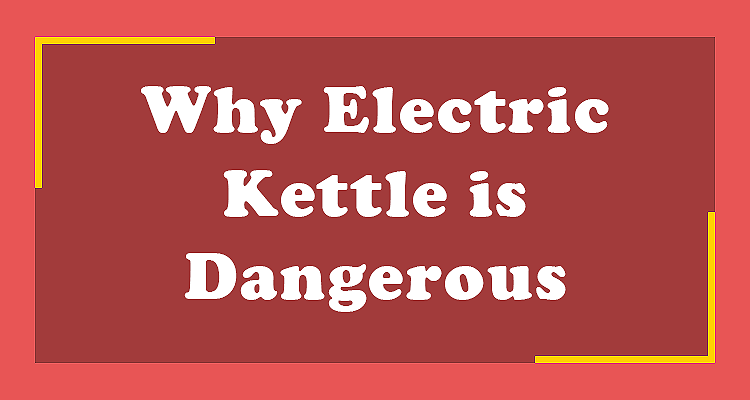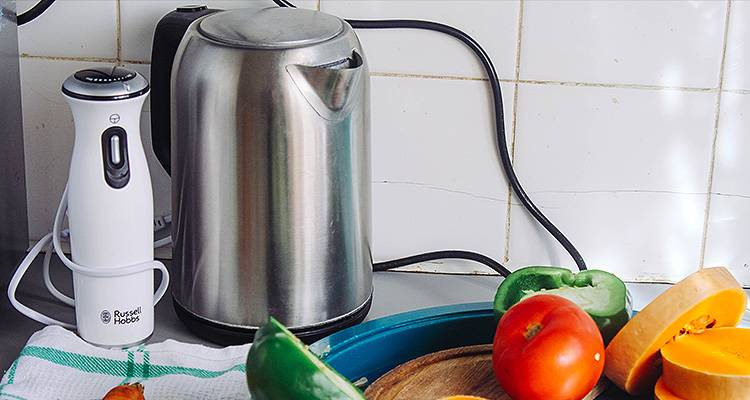
Introduction to Electric Kettles
Electric kettles are beloved for their efficiency in boiling water for our daily tea, coffee, and quick meal fixes. Yet, being aware of “Why Electric Kettle is Dangerous” is crucial to ensure safe usage. Electric kettles contain heating elements, and if mishandled, they can pose risks like scalding, electrical hazards, or even fires. Understanding these dangers is the first step in practicing caution.
Electric kettles have become indispensable appliances in modern kitchens due to their convenience and speed. These appliances excel at quickly boiling water serving various purposes, from brewing tea and coffee to preparing instant noodles. However, it’s crucial to recognize the significance of safety when using electric kettles.
Electric kettles offer numerous benefits, including rapid boiling, energy efficiency, and automatic shut-off features for safety. However, being mindful of potential hazards, such as the risk of overboiling, scale buildup, or malfunction, is equally important.
In this article, we’ll explore the world of electric kettles, their advantages, and the precautions necessary to enjoy the convenience of these appliances without compromising safety.
Common Uses of Electric Kettles
Electric kettles are versatile kitchen appliances widely appreciated for their efficiency in boiling water. They cater to various daily needs, from making hot beverages like tea and coffee to speeding up cooking tasks with boiling water. However, it’s essential to remember “Why Electric Kettle is Dangerous” while enjoying their benefits.
Common uses include preparing instant soups, heating water for oatmeal, sterilizing baby bottles, and even concocting instant noodles. These convenient applications underscore the importance of understanding and respecting the potential risks associated with electric kettles to ensure safe usage in our daily routines.
Is Electric Kettle Harmful
Electric kettles, while incredibly convenient, can pose certain risks if not used responsibly. It’s essential to recognize that these appliances are not inherently harmful but can become so due to negligence or misuse. Common hazards include the potential for scalding from boiling water, electrical dangers if the kettle malfunctions, and the risk of accidents if not handled with care.
However, with proper usage, regular maintenance, and adherence to safety guidelines, electric kettles can remain safe and invaluable kitchen tools. Understanding and respecting these potential dangers is the first step in ensuring safe and trouble-free use.
Hidden Risks of Electric Kettles: Electrical Shock and Fire Hazards
We all love our electric kettles, don’t we? The convenience they bring to our lives is unmatched. With just a flick of a switch, we can have boiling water in no time. But beneath the sleek design and modern appeal lies a potential danger that often goes unnoticed.
Electrical shock hazards are one such risk associated with electric kettles. While they may seem harmless on the surface, faulty wiring or improper insulation can lead to dangerous electrical currents running through the kettle. Imagine reaching for your morning cup of tea only to receive an unexpected jolt! This hidden threat could turn your peaceful mornings into electrifying surprises.
But wait, there’s more! Fire hazards also lurk behind those innocuous-looking kettle exteriors. Overheating due to prolonged use or malfunctioning temperature controls can ignite flammable materials nearby, potentially causing devastating fires. The innocent act of brewing your favorite beverage suddenly becomes a hazardous game when these hidden risks come into play.
So, the next time you reach for that trusty electric kettle sitting on your kitchen counter, take a moment to consider what lies beneath its shiny exterior. Are you willing to gamble with electrical shocks or fire outbreaks? Awareness is key in protecting ourselves from these unseen dangers lurking within our everyday appliances. Stay tuned as we explore why electric kettles may not be as innocuous as they appear…
Recommended Blog It’s Help you to how to use and how to clean Espresso Machine or Coffee Maker
Use Newco Coffee Maker The Bunn Coffee Maker Work Use Hamilton Beach Commercial Coffee Maker Clean Braun Coffee Maker Clean Cuisinart Coffee Maker K Cup Side Work a Ninja Coffee Maker Clean Farberware Coffee Maker Clean Capresso Coffee Maker Clean Hamilton Beach FlexBrew Coffee Maker Coffee Grinder vs Blender Tumbler vs Travel Mug
Factors That Contribute to the Dangers of Electric Kettles: Design, Material, and Maintenance
You’re relaxing at home, craving a steaming tea or coffee. Without thinking, you quickly reach for your trusty electric kettle to boil water. But have you ever stopped to consider the potential risks that lie within?
The design of electric kettles is one of the factors that can give rise to concealed hazards. Some models are poorly designed, with handles that heat up excessively during use, leading to painful burns and accidents. Additionally, specific designs may lack proper safety features, such as automatic shut-off mechanisms or adequate insulation.
The composition of materials used is another significant factor in shaping the potential hazards linked to these kitchen appliances. Inferior quality materials used in construction can lead to issues like rusting, corrosion, or even leaching harmful chemicals into boiled water over time. This poses health risks for those unwittingly consuming contaminated beverages.
Maintenance is another aspect often overlooked when considering the lurking dangers of electric kettles. Refrain from regular cleaning and descaling routines to avoid mineral deposits building up on internal components like heating elements or filters. These deposits compromise performance and pose electrical and fire hazards if left unattended.
We must know these factors influencing our beloved electric kettles’ perilous potentialities. Understanding design flaws, material concerns, and maintenance requirements empowers us to decide which products we bring into our homes. Ultimately ensuring our safety while enjoying that perfect cup of tea or coffee.
Real-Life Examples of Accidents Caused by Electric Kettles
Electric kettles have become a staple in many households, providing convenience and efficiency for boiling water. However, hidden dangers lurk within these seemingly innocent appliances. Let’s explore some real-life examples of accidents caused by electric kettles that will leave you shocked.
In a quiet suburban home, an unsuspecting homeowner plugged in her electric kettle to enjoy a relaxing cup of tea. Little did she know that the faulty wiring inside the kettle had been silently deteriorating over time. As she poured the boiling water into her cup, an unexpected electrical surge caused sparks to fly from the handle, resulting in a painful shock.
Across town, another incident unfolded when a young couple left their electric kettle unattended on their kitchen countertop while preparing breakfast. Suddenly, they were startled by loud popping sounds as the kettle’s heating element malfunctioned and emitted intense heat waves. The scorching steam damaged their kitchen and caused severe burns to both individuals.
These harrowing stories remind us that even our most mundane household appliances can pose unforeseen risks if we overlook safety precautions or fail to maintain them properly. As consumers, it is essential to remain vigilant and informed about potential hazards associated with everyday items like electric kettles.

Tips for Safe Use and Maintenance of Electric Kettles
Electric kettles have become a staple in many households, providing convenience and speed for boiling water. However, it’s vital to remember that any electrical appliance has potential risks involved. To ensure the safe use and maintenance of electric kettles, here are some valuable tips:
Choose quality: Invest in a well-built electric kettle from reputable brands or manufacturers known for their safety standards.
Read the manual: Before using your new kettle, take the time to read the manufacturer’s instructions thoroughly. Understanding its features and limitations is crucial for safe operation.
Mindful placement: Always place your electric kettle on a stable surface away from flammable materials or other heat-sensitive objects.
Regular cleaning: Maintaining cleanliness ensures better-tasting beverages and prevents residue buildup that can lead to short circuits or malfunctions.
Avoid overfilling: Be mindful of the maximum fill lines indicated within the kettle; exceeding these limits may cause overheating or spillage accidents.
Power off properly: Once the water has boiled, make sure you turn off and unplug your electric kettle promptly. Leaving it idle increases fire risk.
Check cords regularly: Inspect power cords periodically for signs of wear or damage. Frayed wires can pose significant hazards if left unaddressed.
By adopting safe practices and being mindful of potential risks, you can fully enjoy the benefits of an electric kettle.
Alternatives to Electric Kettles
In a world where convenience often takes precedence, electric kettles have become a staple in many households. But what if we told you there are alternative ways to boil water that eliminate the hidden risks associated with electric kettles and add charm and tradition to your daily routine?
One such alternative is the good old stovetop kettle. Let’s take a moment to appreciate its simplicity and elegance. Picture yourself standing by the stove, patiently waiting for the water to reach boiling point while enjoying the gentle hissing sound and witnessing firsthand the mesmerizing transformation from liquid to vapor.
Induction stovetops offer another viable option for those seeking a modern twist on this classic method. With their efficient heating capabilities and precise temperature control, these sleek appliances can quickly bring your water to a rolling boil without any potential hazards electric kettles pose.
FAQ’s about Why Electric Kettle is Dangerous
The most common dangers associated with electric kettles include burns from hot water or steam, electrical hazards such as shocks or short circuits, and fire hazards due to overheating or improper usage.
To minimize risks, follow these guidelines:
1. Always read and adhere to the manufacturer’s instructions.
2. Keep the kettle away from flammable materials.
3. Avoid submerging the kettle in water or using it near wet surfaces.
4. Use caution when handling boiling water or hot surfaces of the kettle.
5. Regularly inspect cables and plugs for damage that could pose a risk.
In rare instances, if an electric kettle is faulty, damaged, or misused (e.g., leaving it on without sufficient liquid), it may overheat and potentially cause a fire. However, modern kettles usually incorporate safety features to prevent this from happening.
Older models might need more advanced safety features found in newer ones; thus, they have slightly higher potential risks. It is advisable to replace older models if you notice issues like frayed cords or frequent malfunctions. Upgrading to a newer model ensures better overall safety standards.
Conclusion: Importance of Being Aware of the Risks and Taking Precautions of Electric Kettle
The electric kettle has emerged as an indispensable kitchen companion in our fast-paced lives. Its ability to boil water quickly is a daily convenience, but it’s crucial to remain vigilant about “Why Electric Kettle is Dangerous.” The benefits should always maintain safety awareness. Scalding from hot water, electrical hazards, or potential misuse can transform this efficient appliance into a source of harm.
The key takeaway is the significance of understanding these potential risks and actively taking precautions. Regular maintenance, responsible usage, adherence to safety guidelines, and awareness of the dangers are fundamental.
By respecting these concerns, we can continue to embrace the electric kettle as a valuable kitchen tool, ensuring its place in our lives is one of safety and convenience, not regret.
[…] Why Electric Kettle is Dangerous Clean Mold From Your Portable Ice Maker Meat Grinder vs Food Processor Clean Braun Coffee Maker Clean Cuisinart Coffee Maker K Cup Side Work a Ninja Coffee Maker Clean Farberware Coffee Maker Clean Capresso Coffee Maker Clean Hamilton Beach FlexBrew Coffee Maker Coffee Grinder vs Blender Tumbler vs Travel Mug […]